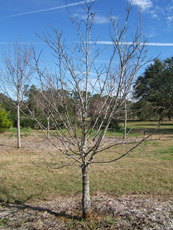Cercis canadensis (Eastern Redbud)

*Click on picture for more images of this species.
- USDA Hardiness Zone: 4B - 9A
- Mature Height: 20 to 30 ft
- Mature Spread: 20 to 35 ft
- Growth Rate: Fast
- Availability: Generally available
- Drought Tolerance: High
- Salt Tolerance: Poor
- Light Requirements: Full sun to partial shade
- Native Origin: Native to Florida.
- Soil Drainage: Tolerates well-drained sites to occasionally wet sites.
- Foliage: Deciduous tree with showy fall color.
- Flowers: Pink to lavender, very showy flowers in spring.
- Pests: The main insect pests are borers, scale and webworm. The main diseases are canker, verticillium wilt and leaf spots.
Description: Eastern Redbud is a moderate to rapid-grower when young, reaching a height of 20 to 30 feet. Thirty-year-old specimens are rare but they can reach 35 feet in height forming a rounded vase. Trees of this size are often found on moist sites. The splendid purple-pink flowers appear all over the tree in late winter, just before the leaves emerge. Eastern Redbud has an irregular growth habit when young but forms a graceful flat-topped vase-shape as it gets older. The tree usually branches low on the trunk, and if left intact forms a graceful multitrunked habit.
Be sure to avoid weak forks by pruning to reduce the size of lateral branches and save those which form a `U'-shaped crotch, not a `V'. Keep them less than half the diameter of the main trunk to increase longevity of the tree. Do not allow multiple trunks to grow with tight crotches, instead space branches about 6 to 10 inches apart along a main trunk. Yellow (although somewhat variable and unreliable) fall color and tolerance to partial shade make this a suitable, attractive tree for understory or specimen planting in full sun. Best not used extensively as a street tree due to low disease resistance and short life, but is nice in commercial and residential landscapes; plant in a shrub border for a spring and fall color display.
Eastern Redbuds grow well in full sun in the northern part of its range but will benefit from some shade in the southern zones, particularly where summers are hot. Best growth occurs in a light, rich, moist soil but Eastern Redbud adapts well to a variety of soil including sandy or alkaline. Trees look better when they receive some irrigation in summer dry spells. Its native habitat ranges from stream bank to dry ridge, demonstrating its adaptability. Trees are sold as single or multistemmed. Young trees are easiest to transplant and survive best when planted in the spring or fall. Containerized trees can be planted anytime; be sure to cut circling roots as the tree grows fast in containers and circling roots form quickly. The beans provide food for some birds. Trees are short-lived but provide a wonderful show in the spring and fall.
Gainesville Observations: Two trees in our plots died about one year after planting, probably due to poor root systems in the field-grown root ball. The remaining tree flowered nicely and is growing fine. Aggressive branches on all three trees were headed back to buds oriented away from the trunk to encourage growth on one main leader. This appears to be a good way to encourage a leader in redbud.

